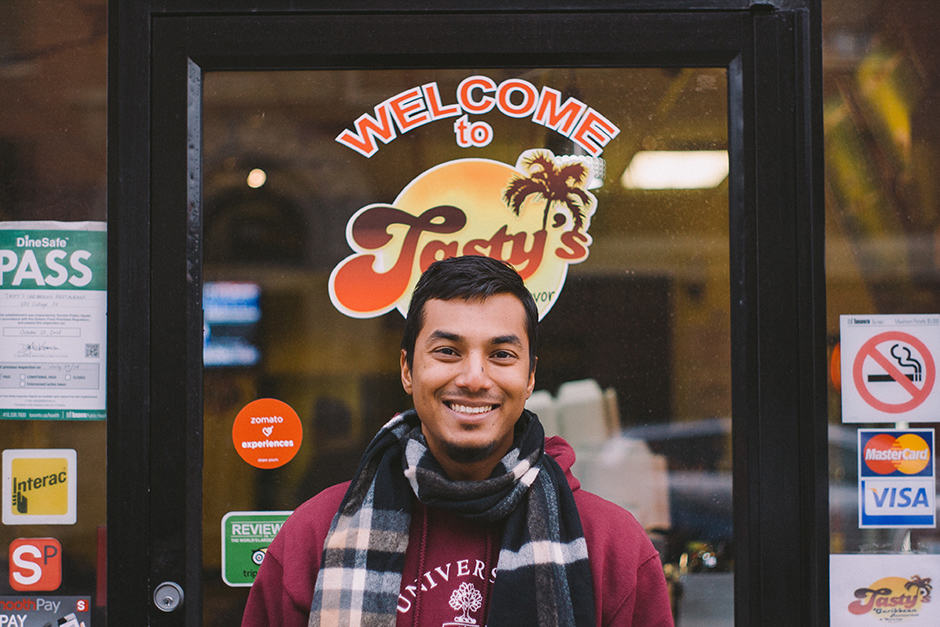Food is something we all have in common. We all need to eat, yet the dietary habits of students at the University of Toronto vary greatly, taking on different meanings, spaces, and ingredients.
For students raised abroad, food often stirs up memories of “home.” Second-year student Priyanka Naik considers Zimbabwe her home, but was educated in Australia and Canada. To her, dishes like boiled peanuts or sadza are reminders of home, while “Tim Tams trigger memories of Australia,” she says. Her Canadian dish of choice? Tim Hortons, of course.
Regardless of their point of origin, most students follow a similar pattern when it comes to feeding themselves. Living on their own for the first time, they are forced into a world of independent culinary struggles and successes. Third-year Rotman student Andre Gadbois says he spent his first semester out of residence “eating a bowl of cereal and two bagels a day.”
Now in his second year off-campus, he has developed dinner staples like pad thai with eggs. He says finding proper grocery stores is the key to saving money, like the Korean grocer on Palmerston Avenue or Honest Ed’s for dry goods.
On the one hand, food options are all around us. The city of Toronto has almost 10,000 restaurants, cafés, and fast food stores that act as prime distractions for many students. As most of us know, it’s a two-sided game of finding the best meals at the best prices.
Yet for some students, food is linked more closely to identity than sustenance. And like our own identities, the range of expression is great.
Carrie,* a fourth-year student in Book and Media Studies, thinks that food is often seen as an indulgence, a private experience, and something that’s not supposed to be talked about.
But she writes about food because she likes thinking about food. To Carrie, talking about food is often perceived along with authority; people expect you to know about the cuisine that corresponds with your cultural background, whether you identify with it or not. At the end of the day, though, she says simply, “I have to eat, so I’ll eat well.”
Niclas Manson, in his first year of a Master’s of Public Health, eats well. After moving to Canada from Trinidad at age six, he credits his parents’ cooking as helping him keep up with his culture. While he says there is not a huge West Indian food scene downtown, he still loves introducing friends to the cuisine when he can.
Food is at the core of Manson’s identity as an immigrant and, also, as a dessert lover. He proudly frequents Demetre’s, the Canadian dessert restaurant, and one of the first things he told me was, “I would marry a Cinnabon if I could.”
Manson notes that he has “never felt bad about what he’s eaten, ever.” This is particularily striking given that food is often linked to guilt and stress, especially during the holiday season.
Also apt for the holiday season is the idea that food means family. To fourth-year Political Science and American Studies student Natasha Abraham, her experience with food is completely connected to her family networks in both Toronto and India. When she thinks of family, she thinks of aunts, uncles, and lots of buffet dinners.
Abraham only began to cook Indian food for herself after moving out of her parents’ home and realizing just how much she missed her mother’s beef curry.
While some seek comfort from eating the foods they like, others enjoy making them. Jeremy Matos, a fifth-year history student, cooks to de-stress. He is the co-president of the Culinary Arts Club and also serves on the Hart House Farm Committee, whose primary role is catering for events.
For him, it is the art that provides the therapy; his favourite culinary activity is making bread. As he says, “It’s such a simple creation yet has drastically differing results based on technique, that it’s an intriguing thing to study.”
Matos agreed that food conjures the idea of a private experience and space. When cooking he thinks of a space “for myself at home, where there is no one to judge the final product but me.”
Food is another way in which we express ourselves; our thoughts and memories, our loved ones, and our past experiences, all piled on a plate.
*Name changed at student’s request


